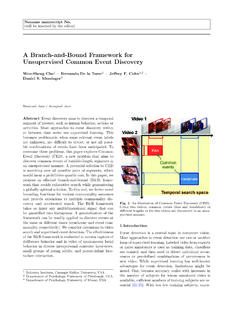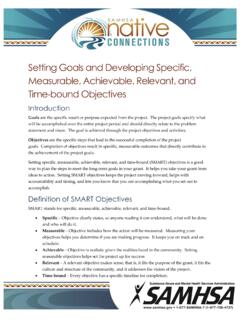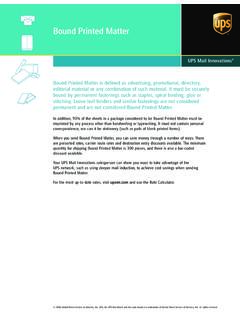Transcription of College-Bound 2017-18 Guide for the Student-Athlete
1 college -BoundStudent-Athlete2017-18 Guide for thePlay college sports Want to play college sports?Learn what it takes to reach the top of your game AverageYour core-course GPA is based on the grades you earn in NCAA-approved courses. Division I WorksheetUse this worksheet to track your progress toward your Division I initial eligibility. Division II WorksheetUse this worksheet to track your progress toward your Division II initial eligibility. TranscriptsAsk your high school counselor to send a six-semester and final high school Tests/DiplomasCheck the guidelines for using an equivalency test as proof of ScoresSend all your ACT or SAT scores to the NCAA Eligibility DisabilitiesInformation on accommodations for students with School StudentsUseful information for home school StudentsUseful information for international students. AmateurismLearn which activities may impact your amateur status. Important TermsLearn some key terms about the initial-eligibility and recruiting CalendarsLearn more about the recruiting rules for Divisions I, II and III.
2 ScholarshipsLearn more about scholarship opportunities at NCAA Letter of IntentUseful information about the National Letter of FOR THE College-Bound STUDENT-ATHLETEHow to Use This GuideThis Guide answers questions for student-athletes and parents navigating the initial-eligibility process. What is the NCAA?Find out who makes up the NCAA membership and how the Association of Going Pro?There are more than 480,000 student-athletes and fewer than 2 percent go ManagementWhat Division I student-athletes should ChecklistFollow a grade-by-grade checklist for navigating the initial-eligibility RegistrationIf you want to play sports at an NCAA Division I or II school, you need to register for a Certification I StandardsLearn the standards to compete at a Division I I Sliding ScaleLearn the ACT/SAT score needed to match your core-course II StandardsLearn the standards needed to compete at a Division II school. Division II Sliding ScaleLearn the ACT/SAT score needed to match your core-course III InformationYou can register for a free Profile Page if you wish to learn more about college is a Core Course?
3 Learn the types of courses that will help you meet the Divisions I and II standards. Nontraditional CoursesLearn the types of nontraditional courses that will help you meet the Divisions I and II of contentsNCAA, Make It Yours and March Madness are trademarks of the National Collegiate Athletic Association. All other trademarks are property of their respective to Use This GuideThis Guide answers important questions for four groups of people involved in the NCAA initial-eligibility process: High school students who hope to compete in college sports at an NCAA Division I or II school. Parents, guardians and family members of high school students. High school counselors and athletics administrators. High school and nonscholastic a question about NCAA eligibility?Find answers to many typical questions about NCAA eligibility by: Reading this Guide . Searching Frequently Asked Questions at Visiting Visiting the Help section of Calling the NCAA Eligibility ELIGIBILITY CENTER CONTACT INFORMATION us on Twitter and Canada except Quebec (toll free): 877-262-1492 International callers: 011-317-917-6222 CERTIFICATION PROCESSINGNCAA Eligibility CenterCertification Box 7136 Indianapolis, IN 46207-7136 OVERNIGHT DELIVERYNCAA Eligibility CenterCertification Processing1802 Alonzo Watford Sr.
4 DriveIndianapolis, IN 462022 Guide FOR THE College-Bound STUDENT-ATHLETE3 Guide FOR THE College-Bound STUDENT-ATHLETEW elcome from the PresidentDear College-Bound Student-Athlete :I am glad you are interested in pursuing your education and sport at the college level. college sports provide a chance to compete at a high level while earning an education that will lead to opportunities beyond your playing career. Through our commitment to academics, well-being and fairness, we at the NCAA strive to provide you with a positive opportunity for personal development and future success, no matter what career path you Guide is designed to educate you, your family and high school administrators about the initial-eligibility process for NCAA Divisions I and II schools. If you are interested in NCAA Division III, please visit , create a free Profile Page on , or contact the athletics office at a Division III campus for its initial-eligibility matter in which division you choose to play, I encourage you to take an active role in the process of preparing for college .
5 More than 1,100 schools are part of the NCAA and sponsor stellar academic and athletics programs, so it is never too early to start looking for your best fit. If you do choose to attend a Division I or II school, the information in this Guide is designed to make your transition to college sports easier, and get you playing the NCAA, we want to make sure high school athletes meet standards that ensure they are prepared to succeed in the college classroom. Initial eligibility affects your ability to receive an athletics scholarship and to practice and compete in your first year as a full-time college student. Work closely with your high school counselors, coaches, parents/guardians and mentors as you transition to you have questions, please reach out to us. The NCAA Eligibility Center strives to make your registration and certification experience positive and wish you the best of luck as you embark on this important journey, and look forward to your future the best,Mark EmmertNCAA PresidentThe NCAA membership and national office work together to help more than 480,000 student-athletes develop leadership, confidence, discipline and teamwork through college is the NCAA?
6 The National Collegiate Athletic Asso-ciation is an organization dedicated to providing a pathway to opportunity for college athletes. More than 1,100 col-leges and universities are members of the NCAA. Those schools work together with the NCAA national office and athletics conferences across the country to sup-port nearly half a million college athletes that make up 19,500 teams competing in NCAA NCAA s diverse members include schools ranging in size from those with hundreds of students to those with tens of thousands. The NCAA s current three-division structure was adopted in 1973 to create a fair playing field for teams from similar schools and provide college athletes more opportunities to participate in national the three NCAA divisions, Divi-sion I schools generally have the biggest student bodies, manage the largest athlet-ics budgets and offer the highest number of athletics scholarships. The Division II approach provides growth opportunities through academic achievement, learning in high-level athletics competition and a focus on service to the community.
7 The Division III experience offers participation in a com-petitive athletics environment that pushes college athletes to excel on the field and build upon their potential by tackling new challenges across learn more about the pathway that s right for you, visit Visit to learn more about opportunities available at NCAA schools. Know current and future academic standards for Division I and Division II. Complete NCAA-approved courses throughout high school. Your high school counselor can help you find and select courses. Register with the NCAA Eligibility Center at during your sophomore year if you are interested in playing college sports. After six semesters, ask your high school counselor to send official transcripts from all high schools you have attended to the NCAA Eligibility HINTS4 Guide FOR THE College-Bound STUDENT-ATHLETEOur Three Divisions3 479,9701 in 25[180,699][120,434][191,398]19 Multiyear, cost-of-attendance athletics scholarships available53 percent of athletes receive athletics aid3092,5241 in 1316 Partial athletics scholarships model56 percent of athletes receive athletics aid 4421,7901 in 618No athletics scholarships75 percent of athletes receive non-athletics aidDIVISION IDIVISION IIDIVISION IIID ivision I schools generally have more students, larger athletics budgets and more athletics department support than schools in Division II or in Division II emphasize a life balance in which academically and athletically gifted students can compete at a high level, while maintaining a traditional collegiate experience.
8 Academics are the primary focus for Division III student-athletes who experience shorter sports seasons, reducing their time away from academic studies and other campus activities. 32%28%40%37%24%39%37%24%39%28%37%24%39%3 7%24%39%37%24%39%28%37%24%37%24%39%37%24 %39%37%32%28%40%37%24%39%37%24%39%28%37% 24%39%37%24%39%37%24%39%28%37%24%37%24%3 9%37%24%39%37%32%28%40%37%24%39%37%24%39 %28%37%24%39%37%24%39%37%24%39%28%37%24% 37%24%39%37%24%39%37%32%28%40%37%24%39%3 7%24%39%28%37%24%39%37%24%39%37%24%39%28 %37%24%37%24%39%37%24%39%37%32%28%40%37% 24%39%37%24%39%28%37%24%39%37%24%39%37%2 4%39%28%37%24%37%24%39%37%24%39%37%32%28 %40%37%24%39%37%24%39%28%37%24%39%37%24% 39%37%24%39%28%37%24%37%24%39%37%24%39%3 7%NUMBER OF SCHOOLSMEDIAN UNDERGRADUATE ENROLLMENTSTUDENTS WHO ARE ATHLETESAVERAGE NUMBER OF TEAMS PER SCHOOLPERCENTAGE OF NCAA STUDENT-ATHLETES IN DIVISIONATHLETICS SCHOLARSHIPSDo schools in all three divisions offer athletics scholarships? Schools in Divisions I and II provide more than $ billion in athletics scholarships annually to more than 150,000 student-athletes.
9 Division III schools do not offer athletically related financial aid, but student-athletes may receive academic or need-based financial aid similar to other students on campus. For more information about scholarships, see page 36. Are initial- eligibility standards similar in all three divisions?If you want to com-pete at a Division I or II school, you must meet academic and amateurism standards set by the NCAA member-ship. Divisions I and II requirements can be found on pages 11 and 14, respec-tively. At Division III schools, you must meet the admis-sion standards set by the school for all incoming students and amateurism standards set by the NCAA membership. For more information about Division III, see page 17. 5 Guide FOR THE College-Bound STUDENT-ATHLETEMEN S BASKETBALLWOMEN S BASKETBALLFOOTBALLBASEBALLMEN S ICE HOCKEYMEN S SOCCERHigh School Student-Athletes546,428429,3801,083,3084 88,81535,155440,322 High School Senior Student-Athletes156,122122,680309,517139 ,66110,044125,806 NCAA Student-Athletes18,68416,59373,66034,554 4,10224,803 NCAA Freshman Roster Positions5,3384,74121,0469,8731,1727,087 NCAA Senior Student-Athletes4,1523,68716,3697,679912 5,512 NCAA Student-Athletes Drafted44352516955175 Percent High School to NCAA to High School to *Percentages based on estimated SPORTSMen:BaseballGolfLacrosseOutdoor Track and FieldTennisVolleyballWomen.
10 Beach VolleyballGolfLacrosseOutdoor Track and FieldRowingSoftball Tennis Water PoloThere are more than 480,000 NCAA student-athletes, and fewer than 2 percent will go pro in their the rest, the experiences of college athletics and the life lessons they learn along the way will help them as they pursue careers in business, education, athletics administration, communications, law, medicine and many more fields. Education is a vital part of the college athletics experience, and student-athletes treat it that way. Overall, student-athletes graduate at higher rates than their peers in the student body, and those rates rise each NCAA conducts 90 national championships in 24 sports across Divisions I, II and III, with 44 championships administered for women and 42 for men. That means almost 54,000 student-athletes participate in NCAA championships each signature events like the NCAA March Madness men s and women s basketball tournaments to rowing, rifle, softball and skiing, the NCAA administers championships to ensure student-athletes have a first-class experience.





